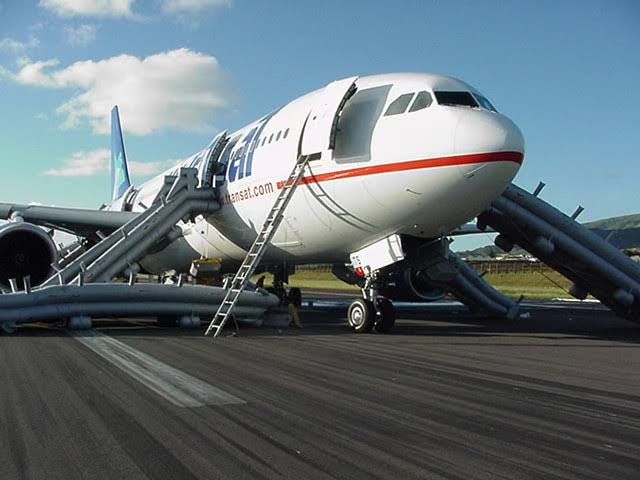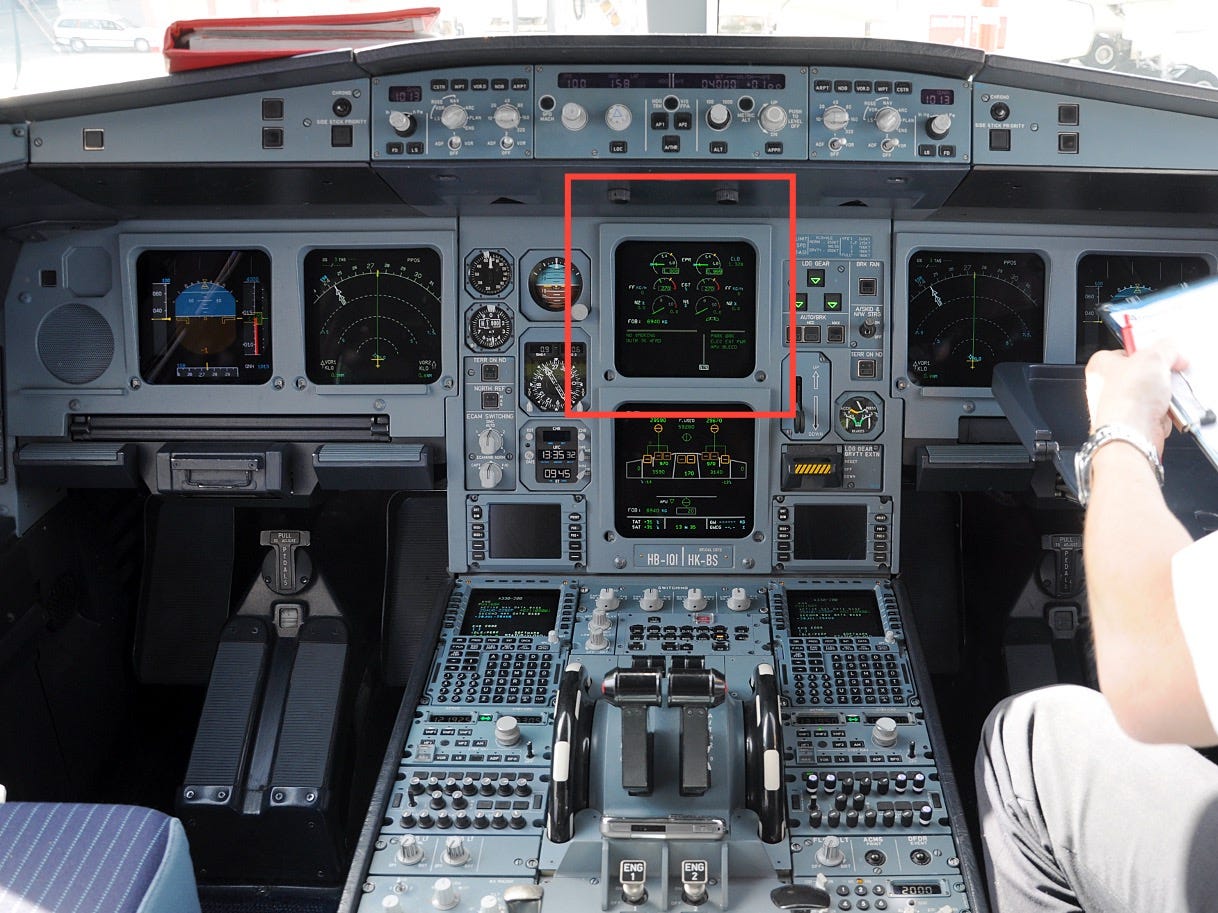Powerless over the Atlantic: the story of Air Transat flight 236
Flight 236 was record breaking, but for none of the reasons that you might expect. It offers lessons for everyone on topics including confirmation bias and human resiliency.

It’s not everyday that an aviation incident report is titled “All Engines-out Landing Due to Fuel Exhaustion” - but this isn’t your normal incident.
On the morning of August 24, 2002 a flight crew was gliding a powerless Airbus A330 halfway over the Atlantic Ocean. The two year old jetliner had taken off from Toronto Pearson International Airport with 47,500 kgs of fuel, but mid-way through the flight their tanks ran empty at 39,000 feet and with 306 souls on board.
As one pilot ran checklists and used their satcom to troubleshoot with maintenance on the ground, the other pilot flew the plane making sure to maintain airspeed to avoid falling from the sky.
This situation stacked most odds against them. Fuel exhaustion is a rare occurrence in commercial aviation, and to have it happen as suddenly as it did on this flight, and in such a remote region exacerbated the seriousness of it.
As we will come to see, yet unbeknownst to the pilots at the time, the subsequent investigation found that the pilots’ actions played a key role in worsening the situation. While they inherited a serious yet manageable mechanical issue, the early assumptions and decisions the pilots made took this from a PANPAN (an urgent situation), to a MAYDAY (an emergency situation), and then eventually to a life-and-death situation.
In the end, and all in one single remarkable flight we witnessed the fallible human transform error into achievement. This demonstrated an enduring lesson for all - even if you make a mistake, you can redeem yourself in the exact same situation and come out a hero.
This is the story of Air Transit flight 236 from Toronto to Lisbon which became the longest commercial airliner glide in history. And it can help you become a better doctor, business person, lawyer or any other profession.
THE BRIEFING
PanPan: Fuel Imbalance
At 05:33 Zulu time, as Air Transat Flight 236 flew over the Atlantic Ocean between Toronto Pearson and Lisbon airports, the Captain and First Officer were presented with an alert from their Airbus A330’s electronic notification panel.
The FUEL IMBALANCE alert signalled to the pilots that their right fuel tanks had materially less fuel in them than their left tanks did. This was an alert for numerous reasons: firstly, you don’t want to starve an engine of fuel, but secondly, seeing as fuel tanks are in the wings it could negatively impact the weight and balance of the aircraft.
Having a fuel imbalance like this is not rare, but it is also not routine so the pilots began to dig deeper and explore the problem.

Within three minutes of this alert the Captain directed the system to transfer fuel from the left side to the right side (where it was low). This was the step to take when following the FUEL IMBALANCE checklist, and in fact was done from memory due to the pilot’s experience.
As minutes went by the pilots began to realize that this may not be just a fuel imbalance issue. They analyzed their fuel levels and realized that they were significantly lower across all fuel tanks than where they should be for this time in the flight.
By their approximation, they were seven tonnes short of fuel. This is when the situation went from being urgent to a full-fledged MAYDAY: the quantity of fuel onboard would no longer get them to Lisbon, their destination airport.
They began to realize that instead of following the FUEL IMBALANCE procedures, they may need to be following the FUEL LEAK procedures. And perhaps they should have been following that from the start.
Mayday: “An unbelievable rate of loss”
As this new reality sunk in, there was something holding the pilots back from accepting it fully: the rate of fuel loss (one metric tonne per 5 minutes) seemed impossibly high. As they would later say in investigative interviews, it was “an unbelievable fuel loss rate.”
“Unbelievable”. This was the beginning of framing bias forming.
The pilots made an earlier assumption that there was no way that this fuel loss could be real. It must be a sensor issue, they discussed. They stuck with their fuel imbalance procedures instead of treating it as a fuel loss. The aircraft engines had recent maintenance work completed and they assumed that the mechanics must have reinstalled a sensor incorrectly.
Though doubting a fuel leak, they did go back into the cabin to inspect if there was a fuel leak from an engine visible through a cabin window. There was nothing visible - because it was nighttime and very difficult to see a leak of vaporized fuel in the dark.
Life-and-Death: FUEL L+R WING TK LO LVL
As the stress levels and workload in the cockpit climbed, the alerts on their ECAM continued to get more and more dire.
Amidst a flurry of action, and about 30 minutes since the initial FUEL IMBALANCE alert, the pilots received the most alarming alert yet: L+R WING TK LO LVL. In other words, fuel levels had reached very low levels in all tanks and the engines would soon flame out and lose thrust.
By this time the pilots had appropriately started to action a diversion to a closer airport. But with the scale of the fuel loss still unclear, they would soon find out that they may not even be able to make it to their diversion airport of Lajes.
Within minutes of this latest alert, the right engine flamed out and lost thrust. Moments later the left engine did the same.
The aircraft was out of fuel at 39,000 feet and 150 miles away from the closest airpot.
What had escalated to a Mayday, was now a life-and-death situation with 306 souls hanging in the balance, including the pilots’ own lives.
Despite the weight of the situation - the thoughts of their families, others’ families, about their legacies - the pilots stayed focussed on solving the situation. This is nothing short of herculean and heroic.
The 152,988 kilogram aircraft now became the world’s largest and heaviest commercial glider. The pilots continued to aviate, navigate and communicate, including hand flying the aircraft for over 30 minutes. No autopilot, limited systems, and no thrust. They had one shot at this - they had to land it on the first try and on a small island in the middle of the dark ocean.
And they did - they landed hard, but everyone survived.
This was the most unlikely outcome, but a true testament to the excellent pilotage and expert pilots in charge of this powerless bird.
⚠️ Read the actual accident investigation here ⚠️
CAUSE
By this point it should be of no surprise that the aircraft had a massive fuel leak out of its right engine. A fuel pipe that was subject to recent maintenance had not been re-installed correctly, and suffered a major fracture that released one metric tonne of fuel every 5 minutes.

If you recall, by treating this as a fuel imbalance issue the pilots had sent “good fuel” from the left side tanks to the right side with the fuel leak. Had they followed the FUEL LEAK procedures, they would have protected the left side fuel and landed safely at a diversion airport.
The pilots did consider and discuss the possibility of a fuel leak, but it did not become their leading theory as evidenced through not completing the FUEL LEAK checklist. To the pilot’s credit, there were other indicators that may have ruled-out a fuel leak, however the most blaring data point - low fuel and rapidly declining fuel in their tanks - was not given the weight it deserved in their decision making.
“The crew stated that they continued to believe that the low quantity indications were caused by some type of computer error, and continued with this belief up to and beyond the flameout of the right engine.”
- Accident report
Unfortunately, despite the CAUTION statement at the top of the FUEL IMBALANCE checklist, the FUEL LEAK checklist was not completed. Had it been completed at the first alert at 05:33, the investigators showed that the plane would have diverted and landed safety with a large safety margin of fuel remaining.

In hindsight, the appropriate action would have been to not transfer fuel from the left side, thus feeding the leak. In the end, the transfer was initiated due to their confirmation bias that the problem was a technical glitch.
“The opening of the crossfeed valve resulted in the fuel from the left wing tanks being fed to the leak in the right engine. In doing the fuel imbalance procedure by memory, the crew overlooked the FUEL IMBALANCE Caution that, in the event that a fuel leak is suspected, the FUEL LEAK procedure should be done.”
- Accident Report
FRAMING & CONFIRMATION BIAS
So, why did very capable pilots with thousands of hours of flying experience jump to conclusions and treat this as an imbalance issue without following the evidence and following the FUEL LEAK checklist?
The accident report went into detail on the psychology behind the pilot’s actions, and what they found is relevant to all of us whether we are pilots or doctors or business people, and everyone in between.
Framing Bias
“Individuals are susceptible to framing bias as they problem solve. In decisions where risk is involved, options are often framed in terms of gains and losses. In the case of losses, when given the choice between a sure loss versus a loss that is less probable but more disastrous, individuals are biased towards the latter, riskier choice.”
- Accident Report
Fuel leaks, especially of the scale experienced on AT flight 236 are exceptionally rare. Because of the low probably of this being a fuel leak, despite the disastrous implications if it were so, the pilots opted for the alternative that was deemed less risky (just an imbalance). This was the framing bias at work.
Confirmation Bias
“Once an initial understanding (mental model) has been formed, the individual will search his/her memory and the immediate situation for additional data relevant to that mental model. Such data, then, are apt to be recalled and regarded as pertinent only to the extent that they confirm the mental model at hand.”
- Accident Report
Early on in the situation the flight crew were quick to assign fault to erroneous data from a faulty sensor that must have been from recent maintenance. The fuel loss data they were seeing was assessed to be impossibly high and instead of treating it as a the leading theory (which would have caused them to commence the FUEL LOSS checklist), they continued to seek confirmation of their erroneous data mental model.
So what can we learn here? Humans are suckers for a good story, especially when it conforms to our world view. We will jump into that pool faster than on a hot summers day.
We are also very good at saying “it can’t be so,” instead of accepting that any variety of outcomes and data is possible. Following the evidence is a hard trait for most humans, it’s why it is held as a virtue in law enforcement.
Stories are how we make sense of the world and about our lives. We use stories to justify decisions, to convince others to see our side, and to protect us from the harsh realities of life. We can make incredible leaps with a story, including jumping to conclusions.
Stories are powerful. Maybe alittle too powerful. And the more powerful the story the easier it is to discount data that disagrees with it. The story that recent maintenance must have installed a sensor incorrectly almost literally caused 306 people to die while a massive fuel leak continued.
RESILIENCY
While not written about nor confirmed by the pilots, it could be believed that at the moment of the engine flame outs, the pilots knew or may have at least doubted that they had properly assessed the situation leading up to this moment.
There may have been a moment where they said to themselves quietly, “wow, the sensor was right.”
That is not to cast doubt on them, it is to emphasize the sheer resilience of their handling of the situaition from this point on - they knew they may be at fault, maybe even in trouble, but they persevered. They flew the aircraft for a mesmerizing 33 minutes without power to a safe landing over the middle of the Atlantic Ocean. This ended up being the longest commercial glide in aviation history.
To hand fly an aircraft in a situation like this requires a truly herculean effort. But to do so all while knowing that this will receive international attention and that your actions right here and now will be scrutinized by countless government agencies around the world, that’s truly heroic.
This is remarkable pilotage and despite sticking to their mistaken mental model, the pilots deserve a hero’s welcome (as they did).
Thankfully both pilots went on to have long careers as pilots. Air Transat had just made a huge investment into their experience and, rest asssured, a suspected fuel leak would not be handled the same way by either (and many other pilots because of the remedies put in place from this situation) ever again.
This goes to show that an innocent oversight should never end a career, and if you are the person in the center of it all, you need to find a way through to a successful outcome. This is leadership.
A single mistake should not define a career. It should not even risk a career. What should be measured is how someone responds to the error.
For all of us, we can take away two lessons from this happy ending:
Recognize confirmation bias, and weed it out. Follow the evidence, stay open to new theories, and stay humble if presented with new evidence.
Just fly the plane. Things aren’t going well? Worried about potential outcomes? Worried that you may have screwed up? Just keep flying. You never know how it will all land.
Let me end with additional praise for these two pilots. Civil aviation is a privilege, not a right. Aviation could easily be reserved just for military use if civil aviation didn’t have the impeccable safety record that it has. This has been achieved because of the fearless and courageous pilots like those on Air Transat flight 236 who has kept aviation accessible to all of us.


